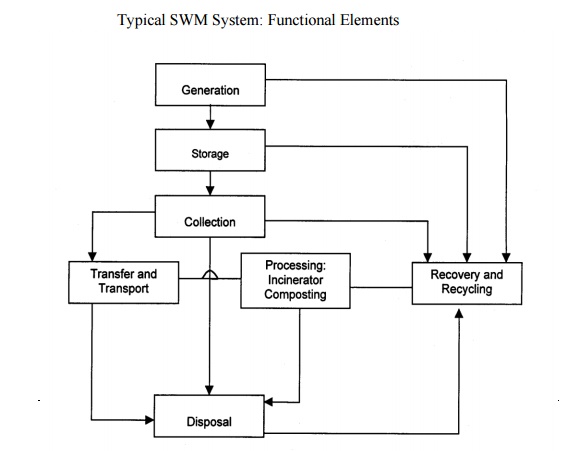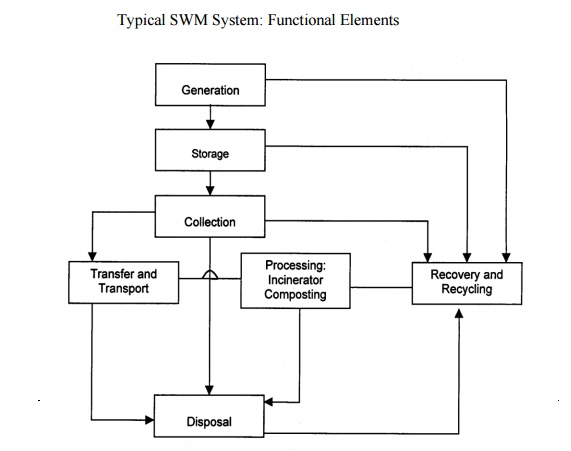Chapter: Civil : Municipal Solid Waste Management : Sources and Types of Municipal Solid Wastes
Solid Waste Management System

Solid Waste Management System
A SWM system refers to a combination of various functional elements associated with the management of solid wastes. The system, when put in place, facilitates the collection and disposal of solid wastes in the community at minimal costs, while preserving public health and ensuring little or minimal adverse impact on the environment. The functional elements that constitute the system are:
(i) Waste generation: Wastes are generated at the
start of any process, and thereafter, at every stage as raw materials are
converted into goods for consumption. For example, wastes are generated from
households, commercial areas, industries, institutions, street cleaning and
other municipal services. The most important aspect of this part of the SWM
system is the identification of waste.
(ii) Waste storage: Storage is a key functional
element because collection of wastes never takes place at the source or at the
time of their generation. The heterogeneous wastes generated in residential
areas must be removed within 8 days due to shortage of storage space and
presence of biodegradable material. Onsite storage is of primary importance due
to aesthetic consideration, public health and economics involved. Some of the
options for storage are plastic containers, conventional dustbins (of
households), used oil drums, large storage bins (for institutions and
commercial areas or servicing depots), etc.
(i)
Waste collection: This includes
gathering of wastes and hauling them to the location, where the collection
vehicle is emptied, which may be a transfer station (i.e., intermediate station
where wastes from smaller vehicles are transferred to larger ones and also
segregated), a processing plant or a disposal site. Collection depends on the
number of containers, frequency of collection, types of collection services and
routes. Typically, collection is provided under various management
arrangements, ranging from municipal services to franchised services, and under
various forms of contracts.
(iv)
Transfer and transport: This functional
element involves:
The transfer of wastes from smaller collection
vehicles, where necessary to overcome the problem of narrow access lanes, to
larger ones at transfer stations.
The subsequent transport of the wastes, usually over
long distances, to disposal sites.
(ii)
The factors that contribute to the designing
of a transfer station include the type of transfer operation, capacity, equipment, accessories and environmental requirements.
(v)
Processing: Processing is required to
alter the physical and chemical characteristics of wastes for energy and
resource recovery and recycling. The important processing techniques include
compaction, thermal volume reduction, manual separation of waste components,
incineration and composting.
(vi)
Recovery and recycling: This includes
various techniques, equipment and facilities used to improve both the
efficiency of disposal system and recovery of usable material and energy.
Recovery involves the separation of valuable resources from the mixed solid
wastes, delivered at transfer stations or processing plants. It also involves
size reduction and density separation by air classifier, magnetic device for
iron and screens for glass. The selection of any recovery process is a function
of economics, i.e., costs of separation versus the recovered-material products.
Certain recovered materials like glass, plastics, paper, etc., can be recycled
as they have economic value.
(vii) Waste
disposal: Disposal is the ultimate fate of all solid wastes, be they
residential wastes, semi-solid wastes from municipal
and industrial treatment plants, incinerator residues, composts or other
substances that have no further
use to the society. Thus, land use planning becomes
a primary determinant in the selection, design and operation of landfill
operations. A modern sanitary landfill is a method of disposing solid waste
without creating a nuisance and hazard to public health. Generally, engineering
principles are followed to confine the wastes to the smallest possible area,
reduce them to the lowest particle volume by compaction at the site and cover
them after each day's operation to reduce exposure to vermin. One of the most important
functional elements of SWM, therefore, relates to the final use of the
reclaimed land.
Typical SWM System: Functional Elements

Related Topics